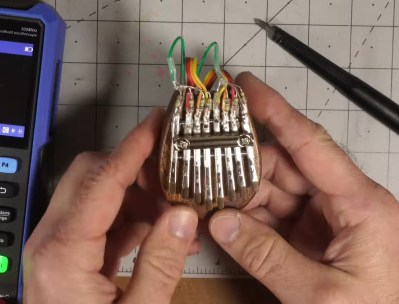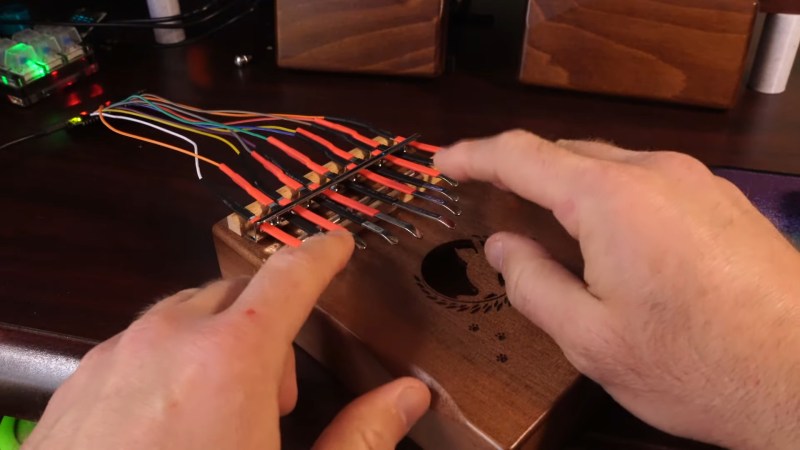The kalimba, or thumb piano, is an easy way to make some music even if you have next to no idea what you’re doing. The only real downside is that they are limited to the twinkly sounds of metal tines being plucked by thumbs.
 [Jeremy Cook] broke the sonic possibilities wide open by converting a couple of kalimbas into capacitive-touch MIDI instruments using the Raspberry Pi Pico. He started with a small one that is curiously made of solid wood. Usually these instruments are at least partially hollow to allow air to resonate inside the body.
[Jeremy Cook] broke the sonic possibilities wide open by converting a couple of kalimbas into capacitive-touch MIDI instruments using the Raspberry Pi Pico. He started with a small one that is curiously made of solid wood. Usually these instruments are at least partially hollow to allow air to resonate inside the body.
After soldering up all the 1 MΩ resistors necessary to utilize the capacitive touch capabilities of the Pico, [Jeremy] found it a bit difficult to play individual notes on such a small instrument, so he made version two out of a much larger specimen.
This time, [Jeremy] cooked up a custom PCB which he is calling the Pico Touch 2, which adds the necessary resistors at the SMD level for capacitive touch sensing and in turn cleans up the wiring a bit. Be sure to check it out in action after the break.
Okay, so you don’t have an iota of musical talent. You could always build a kalimba that plays itself.

















Whoa, I was about to start making a midi controller for an event, but I guess now I’ll just take this as my model. Cute little project, though maybe a bit wasteful with otherwise fine instruments :D I’ll just print it instead
If you like, shoot me an email: hi at jeremyscook dot com or hit me up on Twitter @jeremyscook and perhaps we can work something out!
Loved your Telecaster kill switch install and Tom Morello references in one of your other videos! :-)
Well thank you! Glad we got that little snippet of confusion and/or joking in there :-)
Thanks for the writeup! “[Jeremy] cooked up” – lol.
Since he doesn’t seem to use the vibration of the thing he could just as eaily have used anything metal, and by doing so have a better more ergonomic instrument IMHO.
Even using teaspoons would probably work better for me I expect.
Still though, projects that one thinks could be done better are probably more inspirational than ‘perfect’ ones.
And you can use the code as basis :)
Might be a good fit for the optical pick-ups we’ve seen on Hackaday a few days ago.
Piezo pickups would work better with a kalimba, since the tone of the instrument comes from the sound box. The tines themselves sound pretty lame.
That’s also where most of these cheap kalimbas fail. I’ve made one myself and you can get pretty sweet and much louder tunes out of it with a proper resonating box. There’s also the finger holes which lets you modulate the resonance, giving you nice effects.